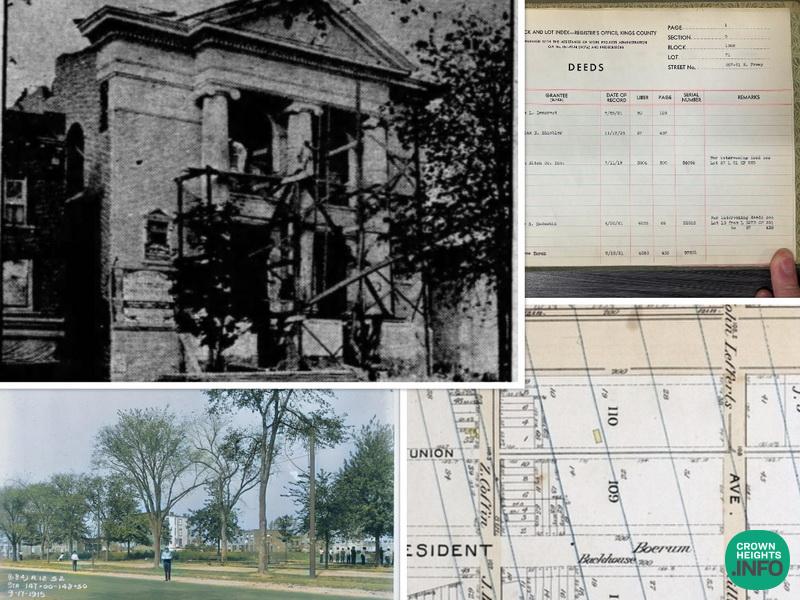
Crown Heights History: 885 Eastern Parkway, Chovevei Torah – Murphy’s Shul
by Shmully Blesofsky
At 885 Eastern Parkway stands a majestic neoclassical building, which is currently home to The United Lubavitcher Yeshiva Mesivta and Zal. The building has a rich history spanning over 100 years, beginning in the early 20th century, so let’s delve into its story.
It began as a small group in Brownsville in the early 1900s. In the 1925 edition of The Mixer and Server, they write that the group was “Not too prosperous” but “A fine body of men who adhered to their religion with tenacity”. They struggled to find a location for their shul, but when a popular local Irish saloon owner named Murphy heard about their predicament he invited them to daven in the back room of his saloon. They accepted his offer, and the shtiebel used Murphy’s saloon for the next few years. According to the book, Murphy became part of the new congregation and turned into a gabbai of sorts, “On Jewish holidays collections were taken up, and no one but Murphy acted as the treasurer”.
The book continues, “they had determined to create a fund to build a sure-enough synagogue,” and with time, “The money in Murphy’s hands as the treasurer of his Jewish friends amounted to considerable…. When prohibition came along, Murphy, who had accumulated a fair fortune, decided to retire from the saloon business, and after imparting that bit of information to his Jewish customers and long-time friends, they concluded that it was time to build their proposed house of worship. They selected a plot on Eastern Parkway… constructed a new and modern synagogue, and it is known as Murphy’s Schule.” Thus we have the origin of the name. In 1919 they temporarily rented a space at 332 Albany Ave and then in 1921, the congregation moved to Eastern Parkway and Albany and constructed a one-story edifice that could seat 600 people.
A 1921 Morgen Journal Article relates, “As the community grew, so did the congregation’s prominence, attracting more distinguished members and becoming an integral part of the area. However, this growth also brought challenges, as some felt that the congregation was moving away from its original values.”
Accordingly, in 1923, the congregation hired Rabbi Jacob Levinson, the rabbi of the Beis Hamedrash Hagadol in Brownsville, as their spiritual leader. Rabbi Levinson was a deeply respected leader and revered by all. A brilliant orator; he was seen as a pillar of orthodox Jewish leadership. He was previously a Rabbi in Chicago, then the principal of Mizrachi’s teachers’ institute, a secretary of the Union of Orthodox Rabbis, and held key positions in Keren Harpod.
Rabbi Levinson was successful in elevating Chovevei Torah from an unremarkable synagogue to a spiritual hub with daily minyanim and shiurim and turned the synagogue into a stronghold of Torah, tzadaka, and religious Zionism. “He was recognized for his deep learning, energy, and practical expertise in congregational organization, particularly through the establishment of daily services and the development of Chovevei Torah that serves as a spiritual hub.”
As the community grew, they ran a successful building campaign and built a beautiful structure worth about $200,000 (about $3.5 million in 2024 dollars). The beautiful 80-foot structure with its three prominent ionic columns and grand steps was completed in time for Rosh Hashana, 1924. The main shul was built on top of the existing one-story structure and you can still see the line of bricks on the side of the building today where the roof of the original building was. Additionally, the noticeably steep angle of the grand staircase at the facade of the building was necessary to direct congregants up to the main sanctuary which sat above the original building.
The completed building stands out due to its unique design. It does not reflect the typical modern Crown Heights synagogue of that era but more in the style of an impressive Brownsville Shul with three huge pillars. When it was built, the Aaron Kodesh faced Lincoln Place, and under the Bima in the center was a beautiful chandelier. There were small lamps throughout which were typical of Brownsville Shuls, and people sat on wooden benches. On both sides, you had an elevated viber shul. The synagogues could seat 1100 people.
In the following decades, Chovevei Torah was a vibrant community center. The synagogue was lively every day of the week, filled with activities and learning. Rabbi Levison delivered inspiring weekly sermons, led daily Talmud study sessions, and established numerous committees and organizations to assist the community. Der Morgan Journal reports, “His kindness, integrity, and cheerful demeanor have united the community, turning the area into a hub for Jewish life and tradition”. The shul also hosted exams for established Yeshivas in America such as the Chaim Berlin Yeshiva, and more importantly, being of the Mizrachi persuasion they frequently held fundraisers for Eretz Yisroel. It is told that the Frediker rebbe said a mammer in Chovie Torah in his visit to America in 1929.
In the post-war years, as many survivors and Chassdim moved to Crown Heights, Chovevei Torah adopted other responsibilities. It hosted Rebbes and in 1957 helped the building committee for the Yeshiva Netzach Yisroel next door at 881 Eastern Parkway when they ran out of room at their Empire Blvd location. The congregation continued to grow for the next two decades or so. In December 1960, they hosted Menachem Begin on a Friday night with frenzied fanfare and an overflowing crowd. This was after Begin had gone to Yechidus by the rebbe on Thursday night after midnight which lasted many hours. They also famously hosted Chazzan Moshe Kouusevsitsky.
However, in the 1960s, Crown Heights experienced a significant exodus of many of its existing residents. In 1970, Rabbi Hershel Shifrin purchased a house across the street, became a member of Chovevei Torah, and davened there every day. In response to a break-in and fire set by vandals, Rabbi Shifrin wrote to the Rebbe asking for guidance regarding going to the shul as opposed to going to Daven in 770. Such questions usually received brief answers. However, the rebbe wrote a strong and encouraging response. regarding davening there every day, the Rebbe’s response: “ונכון במאוד”. “Extremely important”. And regarding being safe: ”התייצבו בעד השכונה (היהודי כמובן).. אזכיר על הציון וזכות ביסוס השכונה תעמוד להם” “Stand up on behalf of the Jewish community, of course.. Azkir al hatzyoin and the merit of strengthening the community will support them.”
Due to the Rebbe’s strong encouragement, Rabbi Shifrin became an active member of the shul. He often davened for the amud and eventually became the vice president and helped other Lubavitchers become members as well. In 1971 as the shul’s membership was in decline, he connected the leadership of Chovevei Torah with the Rashag. They only asked for $6,000 to give to Rabbi Rabinowitz as severance pay and the deed was transferred to the United Lubavitcher Yehsiva.
After the purchase, the Kveutzeh bochurim were told to move from 770 and study in Chovevei Torah, but naturally they wanted to be in 770 near the Rebbe. (where all the action was). On Purim 1972, the Rebbe addressed the “shturem” by quoting the Zohar regarding mayim tachtoinim “lower waters” how it years to be with the higher waters and the yearning
The buchrim studied downstairs, and the grand shul upstairs fell into disrepair. They boarded up the front door due to brake-ins and a lack of use. The grand shul was used for storage for lag baomer floats. That was the state of building for the next 20 years.
In 1992 after the stroke kvutzeh moved back to 770 in order to be closer to the Rebbe, and the Yeshiva had an empty building. Zal moved in, and in 1994 Rabbi Menachem Krinsky joined the Yeshiva. Rabbi Minsky had the monumental task of taking a large 70-year-old building that was in disrepair and making it ready for a yeshiva. He fought an uphill battle for each one of the three renovations and expansions, first adding classrooms for mesivtah, and culminating with a total structural makeover and extension as well as adding by a new floor under the basement adding a kitchen and a dining hall.
Thanks to the work and sacrifice of many in every one of its stages, Chovevi Torah today is a thriving building with a Mesivtah, Zal, and a recent addition of Achei Temimim. Where the famous revered Rov Rabbi Yaakov Levinson gave his classes, you can hear a shiurim from Rabbi Paltiel or YY Jacobson. Where the president once led the congregation, now you have Rabbi Minsky maintaining the place (edit). And where the Jews of Crown Heights proudly walked up the steps to the chazzan on Rosh Hashana in 1924, you now have buchrim heading to class.
In 1898 the Eastern parkway company purchased the Backhouse and Boerum Farms
Lot on Eastern Parkway and Albany Avenue before Chovevei Torah was built circa 1916
Circa 1915 Albany Aveune looking towards Eastern Parkway. On the far right is the empty lot where Chovivie Torah’s first building was built in 1921.
Chovie Torah under construction circa 1924. Noticed the man on top of the scaffolding
Chovie Torah Circa 1930s
Chovie Torah Circa 1940. If you zoom in to the left you’ll see The Tree of Life Temple 881 Eastern Parkway
Chovie Torah circa 1980s. Note the bricked up front door door and broken window above.
Circa 1940 showing the roof of the original building
The Deed transfers 1901-1921
United Lubavitcher Yeshivah Purchased the building in 1971. Although ACRIS says it’s Landmark that never actually place.
Circa 1970. Response to Rabbi Schifrim when he told the rebbe regrading Davening at Chovevi Torah
Der Tog May 3rd 1957
The Mixer and Server (1925) explaining the origins of the name “Murphys Schule”
.
The Standard Union
Sun, Sep 21, 1924 ·Page 30















Anonymous
What a walk back through time.
Most readers will probably not appreciate the time it takes to produce something like this.
It must be like shooting a movie.
Very impressed about your use of the “Mixer-Server” periodical as source material – great find.
Please keep producing content like this.
Shmully
it’s always appreciated. Thank you and yeah nice to uncover History that hasn’t been known in 100 years. it was excited to find out why it was called Murphys Shul and why the building was built with such deep steps etc. and everything else attached to the story. I do wonder if 332 Union St. if it was actually us saloon as well for confusing the story. There was also another shul that went to space
Shmully
(2)
332 Albany Ave. It’s hard to do real research on that since it was just the holdover space before their buildings were put up but it comes up in both English and newspapers. When I do 332 Albany right about the builder who I remember was Henry Roth and then lay out whatever we have until now. it’s always nice to know the full rest of the story
Chaim
In the 1980s the building was used as a simcha hall for smaller events. A few classmates of mine held their bar mitzvahs at Chovevei Torah.
Chaim
Into the 1980s (before the era of L’Chaims) Crown Heighters used to make vorts at Chovevei Torah and the wedding at Jewish Center.
Shmully
Vort vs Lchaims? And I’m assuming you meant they would rent out the downstairs?
ACRIS is Correct
The article states under one of the photos “Although ACRIS says it’s Landmark that never actually place.” However ACRIS does not show that the property itself is individually landmarked. This scenic landmark Notice of Designation shows in ACRIS for all lots adjoining Eastern Parkway, from Grand Army Plaza to Ralph Avenue.
Shmully
Hey thanks a lot for the clarification.